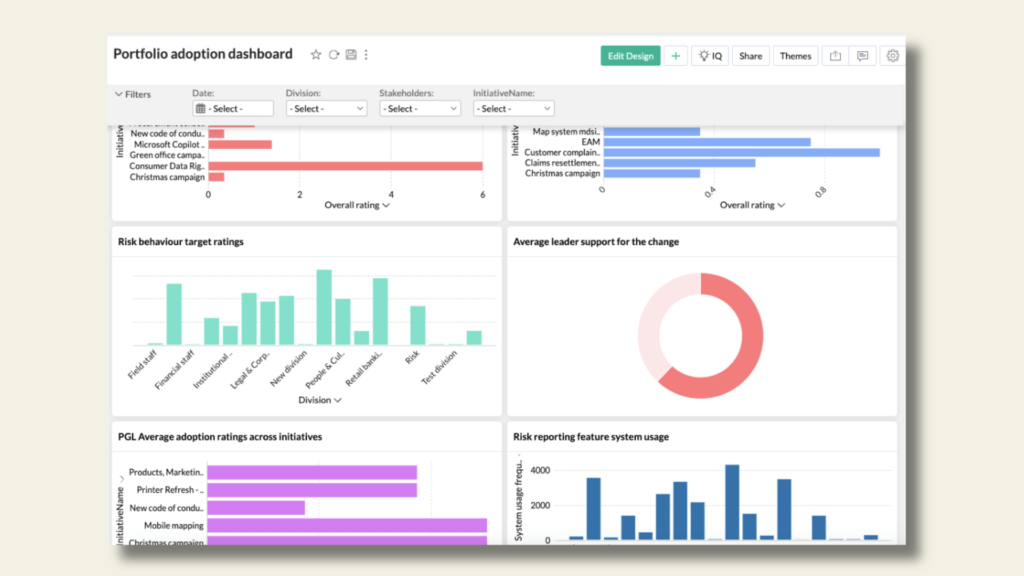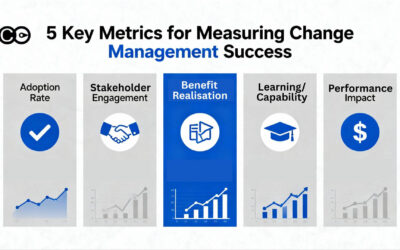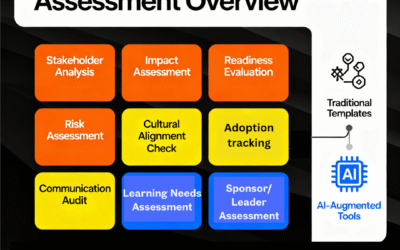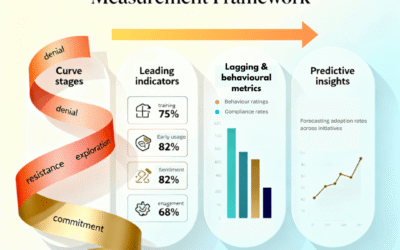The Traditional Path: Learning-Focused Change Management
For decades, the prevailing wisdom in organisational change management has been to build capability through education and training. Senior leaders and managers are sent to workshops, seminars, and e-learning modules to develop their understanding of change frameworks, stakeholder engagement, resistance management, and communication strategies. The rationale is clear: if people know more about change, they will manage change more effectively.
However, while this approach is logical and well-intentioned, its impact is often limited. The learning-focused model is inherently slow and resource-intensive. It requires significant investment in curriculum development, scheduling, and facilitation. More critically, it assumes that knowledge acquisition will naturally translate into changed behaviours and improved business results. In practice, this is rarely the case.
The Limits of Learning-First Approaches
Several challenges hinder the effectiveness of traditional capability-building:
- Delayed Impact: The time lag between learning and application is significant. Leaders may attend a session on change management, but by the time they face a real change challenge, much of the content is forgotten or seems irrelevant to the context.
- Low Engagement or Motivation: Not all leaders are equally motivated to become change experts. Mandatory training can breed resistance or apathy, especially if participants do not see immediate relevance to their roles.
- One-Size-Fits-All: Standardised training often fails to address the unique dynamics, culture, and needs of different teams or business units.
- Lack of Real-Time Feedback: Traditional approaches rarely provide leaders with ongoing feedback about their change leadership effectiveness. This makes it difficult to adjust strategies in real time or learn from mistakes as they happen.
Why Learning Alone Doesn’t Drive Business Results
The core issue is that learning, in isolation, does not guarantee behaviour change or business impact. Senior leaders may understand the theory of change management but struggle to apply it under pressure, in complex environments, or when faced with competing priorities. The disconnect between knowing and doing is well-documented in management literature and is particularly acute in the context of large-scale transformation.
Moreover, traditional change management often relies on intuition and anecdotal evidence to guide decisions. Leaders make assumptions about what will work, based on past experience or prevailing best practices, rather than on empirical evidence from their own organisations. As a result, change initiatives may be misaligned with actual business needs, and the true drivers of resistance or adoption remain hidden.
A New Paradigm: Data-Driven and Experiential Change Leadership
In contrast, a growing number of organisations are achieving significant change maturity by taking a fundamentally different approach. Instead of focusing primarily on education, they are embedding change capability through data and experiential leadership. This approach is not about discarding learning altogether—it is about complementing it with real-time insights, feedback loops, and hands-on experience.
Data-driven change management extends traditional methods by integrating robust processes for data visibility, analysis, interpretation and application. Leaders are equipped not just with knowledge, but with visibility into how change is progressing, where the risks and opportunities lie, and what interventions are most effective in their specific context.
The Power of Data in Change Leadership
When leaders have access to timely, relevant data about change readiness, change capacity, adoption rates, and business impact, several powerful shifts occur:
- Informed Decision-Making: Leaders can move beyond gut-feel and make evidence-based decisions about where to focus their attention and resources.
- Agility and Responsiveness: Real-time data allows leaders to identify emerging issues, test new strategies, and rapidly adjust course based on what is working and what is not.
- Democratisation of Insight: By making change data visible at multiple layers of the organisation, leaders at all levels can take ownership of change outcomes and contribute to collective success.
- Continuous Improvement: Data-driven feedback loops enable ongoing learning and adaptation, rather than one-off interventions.
Experiential Leadership: Learning by Doing
Complementing the data-driven approach is a focus on experiential leadership. Instead of passively absorbing information, leaders are actively engaged in managing real change initiatives, supported by data and feedback. They learn by doing—experimenting with different tactics, observing the results, and refining their approach in real time.
This experiential model is particularly effective because it:
- Bridges the Knowing-Doing Gap: Leaders apply change management principles in the context of their actual work, making learning relevant and sticky.
- Builds Confidence and Competence: Hands-on experience, supported by data, helps leaders develop the judgement and skills needed to navigate complex change.
- Fosters Accountability: When leaders can see the impact of their actions (or inaction) through data, they are more likely to take responsibility for outcomes.
Case in Point: The Impact of Data and Visibility
In my own experience working with organisations on large-scale transformations, I have seen first-hand how the democratization of change data can transform outcomes. When leaders at different layers of the organisation are given visibility into change metrics—such as adoption rates, engagement levels, and business impact—they are better prepared to lead, more agile in their response, and more effective in driving results.
For example, one organisation implemented a change dashboard that provided real-time insights into change adoption, change readiness and the impact and velocity of change across business units. Leaders used this data to identify hot spots, test new engagement strategies, and track the effectiveness of their interventions. The result was a faster, smoother transition with higher levels of buy-in and measurable business benefits.

The Mechanics of Data-Driven Change Leadership
1. Establishing a Change Data Framework
The foundation of data-driven change leadership is a robust framework for collecting, analysing, and sharing change-related data. This framework should capture both quantitative and qualitative insights, providing a holistic view of how change is progressing.
Key Components:
- Change Readiness Assessments: Regular pulse surveys to gauge how prepared teams are for upcoming changes.
- Adoption Metrics: Tracking usage of new systems, processes, or behaviours post-implementation.
- Engagement Analysis: Using surveys, focus groups, or digital tools to understand how employees feel about the change.
- Business Impact and Capacity Measures: Linking change activities to key performance indicators (KPIs), such as productivity, customer satisfaction, employee experience or financial outcomes.
Practical Tip:
Start small. Pilot your data framework in one business unit or for one major initiative. Refine your tools and processes before scaling across the organisation.
2. Democratising Change Data
A critical differentiator in mature change organisations is the democratisation of data. Instead of hoarding insights at the executive or project management level, make data visible and accessible to leaders and teams at every layer.
How to Achieve This:
- Change Dashboards: Develop interactive dashboards that display real-time metrics relevant to each audience—executives, middle managers, and frontline supervisors.
- Regular Data Reviews: Embed data discussions into leadership meetings, project stand-ups, and team huddles.
- Transparent Communication: Share both successes and challenges openly, encouraging a culture of learning and continuous improvement.
Practical Tip:
Don’t overwhelm people with data. Curate dashboards to show only the most actionable metrics for each audience.
3. Enabling Data-Driven Decision Making
With data in hand, leaders must be empowered—and expected—to use it in their decision-making. This requires both capability and accountability.
Steps to Embed Data-Driven Decisions:
- Support on Data Literacy: Equip leaders with the ability to interpret change data and translate insights into action. Provide support as needed.
- Scenario Planning: Use data to run “what-if” analyses and test the likely impact of different change strategies.
- Feedback Loops: Set up mechanisms for leaders to receive feedback on the outcomes of their decisions, closing the loop between action and result.
Practical Tip:
Celebrate leaders who use data effectively to drive change. Share their stories to build momentum and set new cultural norms.
The Power of Experiential Leadership
While data provides the “what” and “how much,” experiential leadership delivers the “how” and “why.” It’s about learning through action, experimentation, and reflection.
4. Embedding Change in Leaders’ Day-to-Day Work
Shift the focus from classroom learning to on-the-job application. Make change leadership a core part of every leader’s responsibilities—not a side project.
How This Looks in Practice:
- Action Learning Projects: Assign leaders to sponsor or lead real change initiatives, supported by coaching and peer learning.
- Shadowing and Rotations: Give leaders exposure to different parts of the business undergoing change, broadening their perspective and empathy.
- Role Modelling: Senior leaders visibly demonstrate change leadership behaviours, setting the tone for the rest of the organisation.
Practical Tip:
Pair less experienced change leaders with mentors who have successfully navigated transformation. Facilitate regular reflection sessions to share lessons learned.
5. Rapid Experimentation and Iteration
Encourage leaders to treat change as a series of experiments rather than a linear process. Use data to test hypotheses, learn quickly, and iterate.
Practical Steps:
- Pilot Programs: Launch small-scale pilots to test new ways of working before rolling out organisation-wide.
- A/B Testing: Try two different engagement or communication strategies and use data to determine which is more effective.
- Retrospectives: After each change milestone, hold structured reviews to capture what worked, what didn’t, and why.
Practical Tip:
Create a safe environment for experimentation. Make it clear that “failing fast” is not a failure, but a valuable source of insight.
6. Building a Feedback-Rich Culture
Change maturity flourishes in organisations where feedback is frequent, actionable, and non-punitive. Data and experiential leadership reinforce each other in this environment.
How to Foster This:
- Real-Time Feedback Tools: Use digital platforms to gather and share feedback instantly.
- Open Forums: Hold regular town halls or Q&A sessions where employees can voice concerns and see leaders respond transparently.
- Recognition Programs: Publicly acknowledge teams and individuals who exemplify data-driven, adaptive change leadership.
Practical Tip:
Encourage upward feedback. Leaders should actively seek input from their teams about what support or information they need to lead change effectively.

Tools and Technologies to Enable Data-Driven, Experiential Change
Modern change leaders have access to a growing suite of tools that make data-driven, experiential leadership scalable and sustainable:
- People Analytics Platforms: Digital tools can automate sentiment analysis, engagement tracking, and pulse surveys.
- Change Management Software: Platforms such as The Change Compass to provide structured frameworks for tracking change progress and impact.
- Collaboration and Communication Tools: Microsoft Teams, Slack, and Yammer facilitate real-time data sharing and collaborative problem-solving.
- Business Intelligence (BI) Tools: Power BI, Tableau, or Google Data Studio can visualise change metrics and make insights accessible to all. Alternatively, use the tailor-designed visuals with The Change Compass.
Practical Tip:
Choose tools that integrate seamlessly with your existing systems and workflows. Prioritise user experience to drive adoption.
Overcoming Common Barriers
Transitioning to a data-driven, experiential change model is not without challenges. Common barriers include:
- Data Overload: Too much data can paralyse decision-making. Focus on a handful of high-impact metrics.
- Cultural Resistance: Some leaders may be uncomfortable with transparency or experimentation. Address this through role modelling and incentives.
- Skill Gaps: Not all leaders are naturally data-savvy. Invest in targeted upskilling and peer support.
Practical Tip:
Start with “coalitions of the willing”—leaders and teams who are eager to try new approaches. Use their successes to build momentum and expand adoption.
The Role of the Change Function
In this new paradigm, the role of the central change function shifts from being the “owners” of change to enablers, advisors and coaches. Their responsibilities include:
- Designing and maintaining the change data framework
- Curating and sharing best practices in data-driven, experiential leadership
- Facilitating cross-functional learning and collaboration
- Providing coaching and support to leaders at all levels
Practical Tip:
Position the change function as a centre of excellence, not perceived as an ‘unnecessary cost centre’. Empower business leaders to take ownership of change outcomes.
Real-World Case Studies: Data and Experience in Action
1. Turning Around Transformation with Data-Driven Communication
A recent case study from ChangeFirst illustrates how a struggling business transformation was revitalised using data analytics. The organisation implemented a communication assessment which provided concrete, real-time data about the effectiveness of their change communications. By analysing this data, leaders identified gaps and altered their communication strategy accordingly. The result: more targeted engagement, improved buy-in, and a successful turnaround of the transformation effort. This case underscores the value of arming leaders with actionable insights, enabling them to make evidence-based decisions and quickly adjust tactics to drive better outcomes.
2. HMRC: Digital Transformation in the Public Sector
Her Majesty’s Revenue and Customs (HMRC) in the UK faced outdated systems and processes that hampered efficiency and customer experience. Their transformation journey was anchored in leadership development, employee engagement, and technology integration. By leveraging digital tools and data, HMRC modernised its operations, resulting in measurable improvements in service delivery and employee satisfaction. This case demonstrates how combining data-driven strategies with experiential leadership—such as empowering employees to test new digital solutions—can deliver sustainable change in even the most complex environments.
3. Adobe: Continuous Feedback and Data-Driven HR Transformation
Adobe’s shift from traditional software sales to a cloud-based model required a complete overhaul of HR practices. The company adopted a data-centric approach to employee engagement, using continuous feedback mechanisms and analytics to inform decision-making. This enabled leaders to rapidly identify issues, experiment with new strategies, and iterate based on real-world results. The transformation led to increased employee retention and a culture of ongoing growth and adaptability.
4. Dashboard-Driven Change at Scale
Organisations that centralise change data and make it accessible through dashboards empower leaders at all levels. This approach mirrors how other business functions—like sales and finance—operate, and it enables leaders to make informed decisions about change capacity, project prioritisation, and resource allocation. The transparency and visibility provided by dashboards foster greater engagement and accountability, making it easier for leaders to see what’s working, what isn’t, and how to course-correct as a team.
5. Process-Centric Change Management through Analytics
A case study presented at the Intelligent Automation Summit highlighted how a hybrid change management and data analytics professional used KPIs and data storytelling to align initiatives with organisational goals. By translating analytics into actionable KPIs, the organisation improved process efficiency, accelerated project delivery, and ensured that change initiatives were tightly integrated with business objectives. This approach demonstrates the power of combining analytics, process management, and people-centric leadership to drive meaningful transformation.
Key Lessons from Data-Driven, Experiential Change Initiatives
- Data Democratization Accelerates Change: When change data is accessible to leaders and teams at all levels, it fosters ownership, agility, and faster decision-making.
- Continuous Feedback Loops Drive Improvement: Real-time data and feedback mechanisms help leaders test, learn, and iterate, closing the gap between planning and execution.
- Integration with Business Strategy is Essential: Data-driven change must be tightly aligned with organisational goals and KPIs to ensure relevance and impact.
- Leadership Engagement is Easier with Data: Leaders are more likely to engage with change initiatives when they have clear, actionable insights at their fingertips, mirroring their experience in other business domains.
- Qualitative and Quantitative Data Both Matter: Combining hard metrics with employee sentiment and qualitative feedback provides a holistic view of change readiness and impact.
Actionable Recommendations for Senior Change Professionals
1. Build a Centralised Change Data Platform
- Aggregate change data from multiple sources (surveys, adoption metrics, business KPIs) into a single, accessible platform.
- Use dashboards to visualise key metrics for different leadership layers, ensuring information is relevant and actionable.
2. Make Data a Leadership Habit
- Embed data review into regular leadership routines—project stand-ups, executive meetings, and team huddles.
- Train leaders in data literacy, focusing on interpreting insights and translating them into action.
3. Foster Experimentation and Rapid Iteration
- Encourage leaders to treat change as a series of experiments, using data to test hypotheses and iterate quickly.
- Create safe spaces for “failing fast” and learning from real-world outcomes, not just theory.
4. Democratise Data and Feedback
- Ensure that change data is not siloed at the top; make it available to middle management and frontline leaders.
- Use real-time feedback tools to capture and act on employee sentiment and engagement throughout the change journey.
5. Align Change Metrics with Strategic Objectives
- Link change metrics directly to business outcomes—such as customer satisfaction, productivity, and financial performance—to demonstrate value and relevance.
- Regularly review and refine metrics to ensure they reflect evolving organisational priorities.
6. Integrate Data-Driven and Traditional Change Practices
- Don’t abandon the people side of change; use data to complement intuition, experience, and stakeholder engagement.
- Balance quantitative insights with qualitative understanding to address both operational and cultural aspects of transformation.
7. Position the Change Function as an Enabler
- Shift from being the “owners” of change to coaches and enablers, supporting business leaders in using data and experiential learning to drive outcomes.
- Curate best practices, provide coaching, and facilitate cross-functional learning to sustain momentum.
The Future of Change Maturity
Organisations that reach significant change maturity do so by making a decisive shift: from slow, learning-centric capability building to a dynamic, data-driven, and experiential model. By democratising data, embedding feedback loops, and empowering leaders to learn by doing, these organisations achieve faster, more sustainable transformation and deliver measurable business results.
Change and transformation professionals who champion this approach will not only accelerate their organisation’s change maturity but also position themselves as strategic partners in shaping the future of business. The imperative is clear: harness the power of data and experience—not just knowledge—to lead change that matters.






